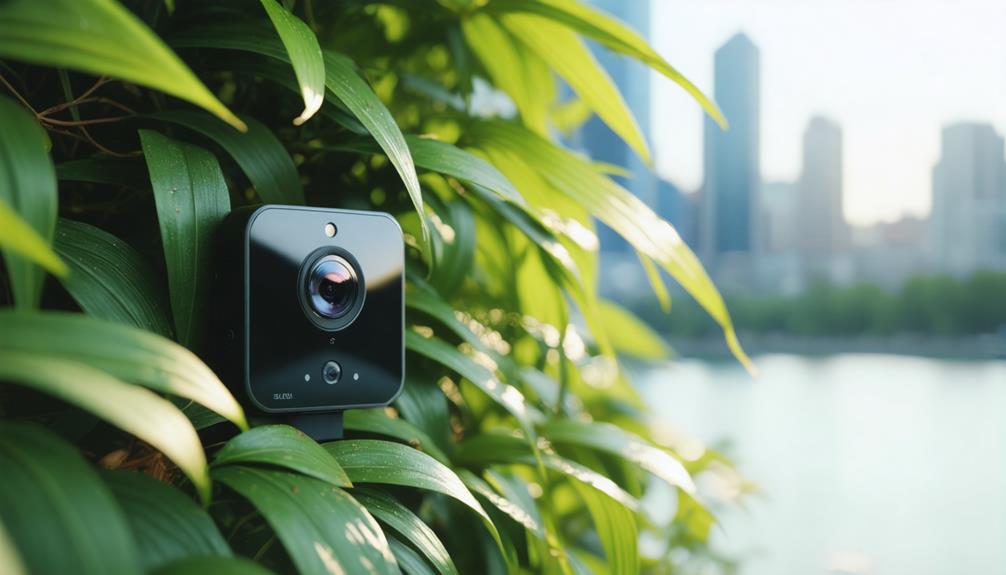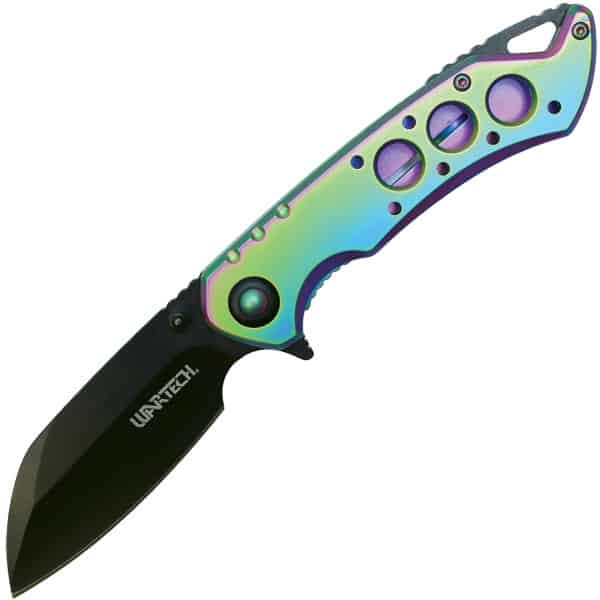
Brainstorm Security Shop

For Orders Over $199

On Any Of Our Products

Details On Refund Page
When you’re gearing up for your next outdoor adventure, selecting the right knife can be as crucial as choosing your destination. You’ve probably noticed that the differences in blade materials and handle designs can greatly influence a knife’s effectiveness and comfort. Whether you’re slicing through tough material or crafting kindling for a fire, the nuances of stainless versus carbon steel, and the ergonomics of the handle, are pivotal. But how do these elements really impact your experience in the wild? Let’s explore the subtle intricacies that can make or break your outdoor tool’s performance.
Choosing the right blade material is crucial for enhancing your outdoor knife’s performance and durability. You’ve got to consider what you’ll be using your knife for, whether it’s slicing through thick brush or precision cutting. Each task might require a different type of steel.
Stainless steel is a popular choice, known for its resistance to rust and corrosion. It’s ideal if you’re often in wet or humid environments. You won’t have to worry about your knife deteriorating quickly. However, stainless steel can sometimes be softer than other materials, which means you might need to sharpen it more frequently.
On the other hand, carbon steel is renowned for its extreme durability and ease of sharpening. It’s perfect for tasks that demand a sharp edge. But keep in mind, carbon steel is more prone to rust. Regular maintenance is essential, including drying your knife after each use and applying oil to prevent oxidation.
Each material has its trade-offs, and your choice should align with your specific needs. Don’t just go for what looks good—think about what’ll serve you best in the long run.
Choosing wisely means you’ll have a reliable tool that stands the test of time and nature’s challenges.

You’ll also need to consider the handle design and comfort of your outdoor knife, as it significantly affects usability and safety. When you’re handling a knife, whether carving wood or preparing camp food, the grip can make all the difference. A poorly designed handle can lead to fatigue, blisters, or even accidents if the knife slips.
Look for handles that fit comfortably in your hand. Materials like rubber and textured synthetics offer better grip in wet conditions, crucial for outdoor activities. Avoid smooth materials that could become slippery when wet. Ergonomically shaped handles, which are designed to follow the natural contours of your hand, can reduce strain during prolonged use.
Also, consider the balance of the knife. A well-balanced knife feels solid and stable in your hand, enhancing control and reducing effort. The handle shouldn’t be too heavy or too light compared to the blade. This balance helps in maintaining precision in your cuts, crucial for tasks like filleting fish or slicing through tough material.
Lastly, check for any additional features like lanyard holes which are useful for securing your knife or adding wrist straps. These small details can improve the functionality and safety of your knife significantly.
Let’s explore the different types of outdoor knives to find the one that best suits your needs. Whether you’re a camper, hiker, or survivalist, there’s a knife out there tailored just for your activities.
First off, there’s the fixed blade knife, a sturdy choice favored by many outdoors enthusiasts. These knives have a solid construction and are typically more durable. They’re ideal for demanding tasks like chopping wood or skinning game.
Next, consider the folding knife. These are more compact and safer to carry since the blade folds back into the handle. They’re perfect for everyday carry and can handle most tasks from preparing food to making quick cuts.
For more specialized activities, you might look at a machete. It’s not just for clearing brush or chopping; it’s also useful in building shelters or cutting large food items. Their longer blades provide greater reach and power, though they require careful handling.
Lastly, there’s the multi-tool, which includes a knife along with various other implements like scissors, saws, and screwdrivers. It’s incredibly versatile, making it a great choice for when you need to pack light but be prepared for anything.
Choose wisely based on your typical outdoor activities and you’ll enhance your wilderness experiences significantly.
Understanding blade shape and functionality helps you match the right knife to your outdoor tasks. Different shapes serve various purposes, and choosing wisely can make a significant difference in your outdoor efficiency.
Consider the clip point blade, a popular choice for hunters. Its fine point allows for precision in tasks like dressing game, making it invaluable when you need accuracy more than raw cutting power.
On the other hand, the drop point blade offers a stronger tip and a large slicing area, perfect for general tasks around the campsite from preparing food to cutting ropes.
If you’re into bushcraft, you’ll likely prefer a full-tang fixed blade for its durability and robustness. The Scandinavian or ‘Scandi’ grind on these blades is ideal for wood carving and other tasks that require controlled, precise cuts. It’s less likely to snag on material, making it perfect for whittling and crafting tools from wood.
For those who prioritize versatility, a tanto blade with its angular edge is excellent for piercing tough materials. Though not the best for slicing, its reinforced tip is designed for pushing through hard surfaces without breaking, which can be critical in survival situations.
Choosing the right blade shape enhances your tool’s effectiveness, directly impacting your outdoor experience.
When choosing an outdoor knife, it’s crucial to consider both its weight and portability to ensure it suits your mobility needs. You’ll likely carry your knife for extended periods, so a heavier knife can become a burden, especially on long treks or climbs. Conversely, a too-light knife mightn’t perform robust tasks effectively.
You should assess the knife’s balance between weight and functionality. Lightweight materials like titanium or composite handles can reduce the overall weight without compromising strength. Consider the knife’s sheath as well; materials like Kydex are durable yet light, making them ideal for easy carry.
Moreover, the size of the knife affects its portability. A compact knife is easier to pack and less likely to snag on equipment. Look for a model with a streamlined design that fits comfortably in your pack or on your belt.
Finally, think about how you’ll carry the knife. Options like a belt loop, clip, or lanyard hole add convenience and accessibility. Ensure that the carrying method is secure yet easy to access when you need your knife quickly.
Choosing the right balance will enhance your outdoor experience, making sure your knife is both a handy tool and not a hindrance.

To keep your outdoor knives in top condition, regular maintenance is essential. You’ll want to start by cleaning your knife after each use. Wash it with soap and warm water, then thoroughly dry it to prevent rust. Even stainless steel can rust under the right conditions.
You should also oil your knife regularly. Use a lubricant designed for knives to protect the blade and enhance its functionality. Apply a small amount on the blade and handle, then wipe off any excess. This not only keeps the knife working smoothly but also prevents moisture from causing damage.
Don’t forget to sharpen your knife periodically. A dull knife isn’t just ineffective but also more dangerous because you have to exert more force to cut through materials. Use a quality sharpener and follow the manufacturer’s instructions carefully to maintain the blade’s edge.
After ensuring your outdoor knife is well-maintained, it’s important to focus on safe handling and proper usage techniques. Here’s how you can use your knife safely and effectively.
Firstly, always cut away from your body. This reduces the risk of injury if the knife slips. Keep your fingers clear of the blade’s path by using a stable cutting surface and securing the item you’re cutting. Never use your thigh or hand as a cutting board!
It’s also vital to keep your knife dry and clean, especially the handle. A slippery grip could lead to accidents. After using your knife, clean it immediately to avoid rust and degradation.
When passing a knife to someone else, offer the handle, not the blade. Make sure the other person has a firm grip before you let go. This prevents accidental cuts.
Lastly, carry your knife in a sheath or a protective case when not in use. This safeguards you and others from unintended injuries and keeps the blade in good condition for longer.
You’ve seen how crucial the right blade material and handle design are for top-quality outdoor knives.
Whether you’re camping, hiking, or fishing, choosing the right type, shape, and weight of the knife ensures your adventures are safe and efficient.
Stick with trusted brands, and don’t forget regular maintenance and safe handling practices.
Invest wisely, and your outdoor knife will be a reliable companion for all your wilderness explorations.
Stay sharp and explore confidently!

Brainstorm Security Shop
1867 Caravan Trail
Ste 105
Jacksonville, FL 32216
Call us toll free: (800) 859-5566